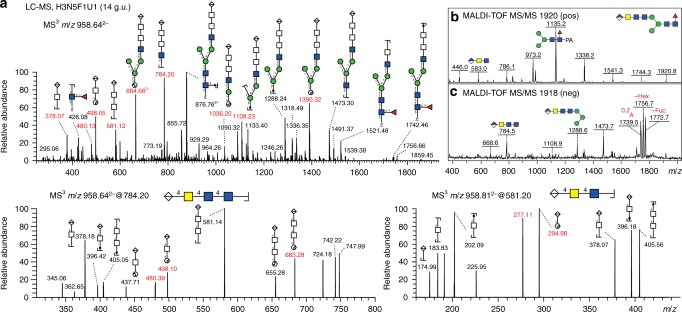Fig. 7.
Negative mode LC-ESI–MSn of a glucuronylated glycan. a The Hex3HexNAc5Fuc1HexA1 m/z 1920 glycan eluting at 14 g.u. (see also corresponding positive and negative mode MALDI-TOF–MS/MS data in b and c, whereby the latter shows some of the same non-cross-ring fragments as the ESI-MS/MS) and containing a HexA1-4HexNAc-4HexNAc-4GlcNAc motif as shown by MS2 of ions at m/z 958.64 (Hex3HexNAc5HexA1Fuc1-PA, [M−2H]2−) and MS3 of ions at m/z 784.20 (HexNAc3HexA1, [M−H]−) and at m/z 581.20 (HexNAc2HexA1, [M−H]−). Fragmentation ions at m/z 664 and 1390 were annotated as 2,4A and 0,2A cleavage of penultimate GlcNAc, both cleavages are diagnostic ions for N-glycans69. The presence of fragmentation ions at m/z 1036 (0,3A of βMan) and “D ions” at m/z 1090/1108 suggest the HexNAc3HexA1 motif linked to Man on the 6-antenna. No fragments are compatible with the presence of terminal HexNAc, while a series of B ions at m/z 378, 581 and 784 suggests a linear HexA-HexNAc-HexNAc linked to β1,2-linked GlcNAc on the 6-antenna. To determine the linkage between HexA-HexNAc-HexNAc, MS3 of the fragmentation ions at m/z 581, which contain HexNAc2HexA1, was performed. Fragments at m/z 295/277 (0,2AHexNAc/0,2AHexNAc-H2O) suggest terminal HexA linked to C4 of HexNAc; the ions at m/z 295 would be compatible with either a 3-, 4- or 6-linkage, but the m/z 277 fragment is most compatible with a 4-linkage. In addition, fragmentation ions at m/z 498/480 (0,2AHexNAc/0,2AHexNAc-H2O) indicate the presence of HexA-4HexNAc linked to C4 of HexNAc. Taken together, this special N-glycan antennal motif was annotated as a HexA-4HexNAc-4HexNAc sequence linked to the β1,2-linked GlcNAc on the 6-antenna

